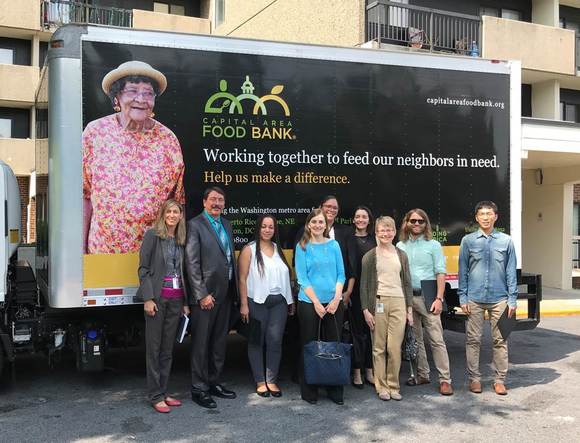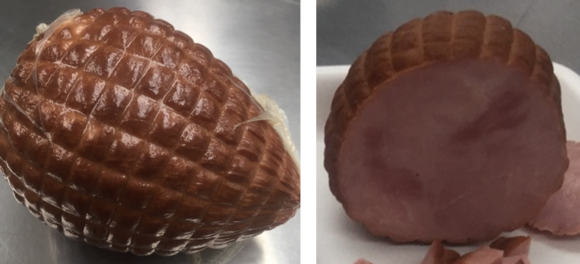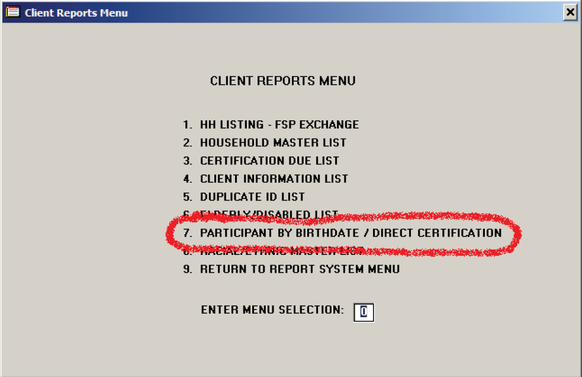NAFDPIR President Meets with FNS Staff
 Tod Robertson (on the left) pictured with FNS staff at Capital Area Food Bank.
This past summer, Tod Robertson, the newly-elected president of the National Association of Food Distribution Programs on Indian Reservations (NAFDPIR), visited with USDA staff within the Food Distribution Division (FDD) of FNS. During
this meeting, Mr. Robertson was given an overview of the recent FDPIR activities,
and discussed policy, communications, nutrition, technology, and
customer support for complaints. He also met with staff from the Under
Secretary's office as well as with staff from the USDA Office of Tribal Relations. In
addition, Mr. Robertson previewed three items that will be made available in the FDPIR
food package: a bakery mix product in a smaller 20 ounce bag, applesauce in
6-cup sleeves, and the new holiday ham, all featured below!
 Pictures of the new, smaller 20 ounce version of the bakery mix (left) and the new, 6-cup sleeve of apple sauce (right).
 New Income Guidelines and Guide Rates for FDPIR!
Effective October 1, 2017, new FDPIR income eligibility standards were released for FY 2018. These standards, known as Exhibit M, represent the net monthly income limit for each household size to determine eligibility for FDPIR. For example, the net monthly income limit for a household of one is now $1,165. A new FDPIR guide rate was also released effective October 1, 2017. The guide rate, referred to as Exhibit O, included changes based on recommendations made by the FDPIR Food Package Review Work Group. As a part of these changes, bison has now been incorporated as a permanent USDA Food item, so FDPIR participants may now select bison as one of their meat options every month!
|
Holiday Ham
This holiday season, USDA is pleased to introduce a new
formulation for the holiday ham product for FDPIR! This change is a result of the FDPIR
Food Package Review Workgroup's request that USDA explore an improved
product profile. The new item has a
number of changes from the previous formulation, including a teardrop shape, a
dark mahogany colored exterior with a netting imprint, and a whole muscle
texture. The photos below provide an example of the appearance of the new formulation.
If you have any comments or feedback about
this item, please send them to USDAFoods@fns.usda.gov.
 The new formulation of the holiday ham, featuring a teardrop shape, dark mahogany colored exterior, and improved texture.
 Update on the FDPIR Shell Egg Pilot
USDA is conducting a shell egg pilot at thirteen (13) selected Indian Tribal Organizations (ITOs): Seneca Nation, Confederated Tribes of Siletz, Confederated Tribes of Warm Springs, Klamath Tribe, Standing Rock Sioux Tribe, Spirit Lake Sioux Tribe, Trenton Indian Service Area, Leech Lake Band of Ojibwe, Red Lake Band of Chippewa Indians, White Earth Band of Chippewa, Alabama-Coushatta Tribe of Texas, Mississippi Band of Choctaw Indians, and the Cherokee Tribe of North Carolina. In this program, participants receive one dozen shell eggs, delivered through the United States Department of Agriculture (USDA) Department of Defense (DoD) Fresh Fruit and Vegetable Program (USDA DoD Fresh), instead of powdered egg mix. Throughout the pilot and its recent expansion, sites have provided feedback to the USDA that has allowed staff to resolve issues quickly. As the program continues, USDA staff will continue to evaluate it and work closely with the pilot sites to improve their experience.
Questions about the shell egg pilot can be directed to Blair Tucker-Gruchala at Blair.Tucker-Gruchala@fns.usda.gov
|
Lummi Nation Uses the Food Distribution Program Nutrition Education Grant to Help Participants
 Photo from the "Jamming with the Commod Squad" session, where participants learn to make jam from locally grown blueberries, raspberries and strawberries.
At Lummi Nation, the Food
Distribution Program on Indian Reservations (FDPIR) goes beyond providing
monthly food packages. Referred to as the Commod Squad, Lummi Nation’s food distribution
team has facilitated a variety of nutrition education activities for FDPIR
participants and the community through funding from the Food
Distribution Program Nutrition Education (FDPNE) Grant. The goal of Lummi Nation’s projects have been to increase consumption of fruit and
vegetables among FDPIR participants, encouraging them to make half their plate
fruit and vegetables.
As part of FDPNE grant activities, Lummi
Nation has hosted cooking demonstrations and taste tests to help participants find
new ways to incorporate fresh produce into their everyday lives. In addition,
the Tribe has conducted a series of over 30 nutrition education sessions and food
demonstrations that have included topics related to fruits and vegetables, such as
gardening, produce safety, and healthy cooking techniques. “Jamming with the
Commod Squad” has been a popular session during which families make jam from locally
grown blueberries, raspberries and strawberries (pictured above). Canning has
been a Lummi tradition for years, and through these activities participants have learned a traditional food preparation technique utilizing locally grown produce.
In celebration of the end of the nutrition education series, the Tribe holds a
“Grand Finale” nutrition fair that features nutrition education resources and taste
tests of healthy recipes that feature local, traditional and USDA Foods.
First Nation Institute's New Nutrition Education Toolkit for FDPIR!
The First Nations Institute has launched a new FDPIR Nutrition Education Toolkit!
The toolkit provides resources to help Native communities prepare healthy and
tasty meals using the foods available through the FDPIR program. It contains
free educational resources, including several cookbooks, videos featuring
traditional foods and cooking methods, and additional materials on traditional,
ancestral beverages. One of the featured resources is the First Nations
cookbook, titled Cooking Healthier with FDPIR Foods, which provides healthy recipes using foods found in the FDPIR food package. All
of these resources were compiled by the Nutrition Education for Native American
Communities project, which is the result of a partnership between First Nations
and NAFDPIR. Links to these materials can now be found in the FDPIR Sharing
Gallery, in both the Nutrition
Education and Recipes
& Cookbooks sections.
USDA Staff Participate in Second Annual Conference on
Native American Nutrition
In September, USDA Staff attended the Second Annual
Conference on Native American Nutrition. The conference, held in Prior
Lake, Minnesota, is hosted by the Shakopee
Mdewakanton Sioux Community in collaboration with the University of Minnesota, Healthy Foods,
Healthy Lives Institute and supported by the Seeds of Native Health, a national
campaign established to improve Native American nutrition which is supported by the Shakopee Mdewakanton Sioux Community.
The conference brings together tribal officials,
researchers, practitioners, government agencies, and other stakeholders to
discuss Native nutrition through the lens of indigenous experience and academic
research. This year, general sessions tackled
complex topics such as decolonizing food and nutrition to reintroduce Native
perspectives to the conversation, implementing indigenous evaluation
frameworks into projects and research, and translating research into practice. Breakout sessions offered skill-building workshops on topics such as
documenting the traditional food system in Native communities, organizing youth to work on improving Native nutrition,
and building tribal and university partnerships.
USDA staff hosted an exhibit table where they provided
materials on FDPIR as well as the Office of Community Food Systems’ Farm
to School resources. Staff used this opportunity
to interact with attendees and provide more detailed information on USDA
programs. The conference offered a unique opportunity to learn more about Native American cultural and traditional perspectives on nutrition science,
health promotion, and successful nutrition and health programs for Native
Americans. This information will be invaluable as USDA continues to work collaboratively with the FDPIR community to improve the food package and support nutrition education.
Receiving and Inspecting Produce
Through the USDA DoD
Fresh Program, USDA is able to offer a
select variety of fresh produce to Indian Tribal
Organizations (ITOs). ITOs use the Fresh
Fruit and Vegetable Ordering and Receipt System (FFAVORS)
to order fresh in-season produce as part of their food package benefit. It is the ITO’s
responsibility to inspect each delivery as it is being unloaded to ensure the overall quality and condition of the items as well as to verify that the appropriate quantity was received to accurately receipt in FFAVORS.
At the time of delivery
and before
the truck leaves, check the following:
- Check each order to make sure you
received the items you ordered through FFAVORS, note any missing items on the
delivery document;
- Verify the quantity received with your
FFAVORS order sheet, not the vendor’s shipping document. Confirm that the
quantity of the product ordered and received matches the quantity on the
delivery document. Carefully count the product before the vendor leaves. Note any
shortages or overages on the delivery document;
- Examine
the quality of the produce, inspect for defects. Open cartons to check produce quality
and condition. Randomly check product from each layer on the pallet, not just the
top layer cartons. Be sure to check for condition defects that will worsen over time. Examples of condition defects are: bruising, sunken
discolored areas, shriveling, surface discoloration, and decay.
- Produce in boxes that appear damaged
should be carefully checked;
- Document any issues on the delivery
document, prior to signature, take photos, and make copies of this
documentation and maintain for your records.
It is important to
train staff on how to properly accept and inspect produce. Take time to walk
around pallets, count cases, open cases, and, if needed, open internal
packaging to examine produce. After a thorough inspection, staff should reject poor
quality product.
USDA
DoD Fresh Complaint Process: ITOs are to report
issues with produce received through the USDA DoD Fresh concerning produce
quality, condition, and delivery to the appropriate DLA
Service Representative, the vendor, and the appropriate
FNS Regional Office staff.
If issues are reported
and not resolved, please contact the USDA Complaints Team at 800-446-6991. We will
work with DoD to resolve the issue. We welcome your feedback on produce
received through the USDA DoD Fresh Program.
For more information on
“The Basics” of the USDA DoD Fresh Program in the FDPIR, please view our webinar, available on YouTube at: https://www.youtube.com/watch?v=8kmhfF_-oL0&t=3s.
USDA
Foods Complaint Hotline Email: USDAFoodsComplaints@fns.usda.gov
The Complaint Team is available Monday-Friday, 6:00
a.m. – 5:00 p.m. Eastern Time.
New Look for WBSCM
At the end of October, many of the supporting software
components for the Web-Based
Supply Chain Management (WBSCM) system were upgraded to improve system
performance and provide some new navigational tools. As mentioned in the system notices sent out
prior to the upgrade, two key changes that require action from users are:
- All users should review the updated browser
requirements for WBSCM. It may be
necessary to work with your local IT support staff to make changes on your
computer. Instructions are available in the WBSCM document library: Help->Training->Job
Aids->General Help->WBSCM Browser Settings and Helpful Tips.
- All users will need to delete and re-create any
previously saved shortcuts to frequently used transactions (Portal Favorites). Instructions
are available in the WBSCM document library:
Help->Training->Job
Aids->General Help->WBSCM Portal Favorites.
In addition to these items, there are some subtle
changes to the look of the header, tabs, and navigation menu, including repositioning
of the WBSCM logo.
 Screenshot that highlights new updates to the look and feel of the WBSCM interface.
Some of the new navigation tools include:
-
Back, Forward, History, and Favorites links are located in the menu
bar.
- Tabs are visibly
highlighted when selected.
- A breadcrumb
trail shows the navigation path to the current transaction.
- The
‘Options’ menu is more clearly labeled to facilitate access to help resources
for the current transaction.
If you have questions about these changes, contact the WBSCM Service Desk or call
(877) 927-2648.
Direct Certification Report for AIS
Children whose households receive benefits under FDPIR
are “categorically
eligible” for free school meals. To facilitate the direct certification
process, a report is available in the Automated
Inventory System (AIS), which provides local school authorities with a list
of eligible school-age children.
In AIS, the Participant
By Birthdate / Direct Certification report is available as menu option 7 in
the Client Reports Menu. There are two versions of the report, depending on the
intended use. Both include similar data
(name, address, date of birth) although the titles are different.
 Screenshot of the Client Reports Menu in AIS.
Three dates (month/year) are required to produce the
report. For the Date of Birth fields the “Age at reporting date” to the right
will update automatically. Confirm that the date entered corresponds to a valid
age.
-
Beginning Date of Birth – the birthdate for the oldest children
(usually 18 years old)
-
Ending Date of Birth – the birthdate for the youngest
children (usually 5 or 6 years old)
-
Terminated on or after – the program month and year used to determine
eligibility
 Screenshot of the AIS Direct Certifcation menu.
The Direct Certification report produces both a printed
version and a text file (PARTICIPANT.TXT and PARTICIPANTDOB.TXT), which can be found
in the FNS152 subfolder where AIS was installed. This file can be opened in a spreadsheet or
other application. The file can also be sent as an email attachment.
A procedure
guide for this report and other helpful resources for working with AIS are also
available in the AIS
Document Center.
USDA staff will be participating in these upcoming meetings in 2017 and 2018. We look forward to the opportunity to meet you and hope to see you there!
November 29-30, 2017: Members of the FDPIR Food Package Review Work Group will
convene for a face-to-face meeting at the FNS National Office. This yearly meeting will
include discussion of traditional foods and establishing priorities to continue improving the FDPIR food package.
June 11, 2018: The 2018 annual conference hosted by NAFDPIR will
be the week of June 11, 2018 in Reno, Nevada.

Here's how to sign up for these updates via GovDelivery:
1. Go to the Food Distribution website.
2. Click on the red envelope on the row of social media
icons on the top right of the page.
3. Enter your email address and click "Submit."
4. Check the boxes to select your topics of interest. For
these e-letters, scroll down to the Food Distribution category and click the
plus sign to the left of the check box to expand the list and view all the
sub-categories. Check these sub-categories to receive the corresponding
e-letters:
*USDA Foods --> receive all "USDA Foods from Farm
to Plate" general + program-specific e-letters
*Commodity Supplemental Food Program (CSFP) --> receive
"Household Highlights" e-letter
*The Emergency Food Assistance Program (TEFAP) --> receive
"Household Highlights" e-letter
*Food Distribution Program on Indian Reservations (FDPIR) -->
receive "FDPIR Connection" e-letter
*Schools/Child Nutrition Commodity Programs --> receive
"Spotlight on Schools" e-letter
5. Update your
subscription preferences any time by following the above steps or clicking on
the Subscriber Preferences Page link at the bottom
of any of the e-letter email messages you receive from
GovDelivery. Questions? Contact us at USDAFoods@fns.usda.gov
|
|